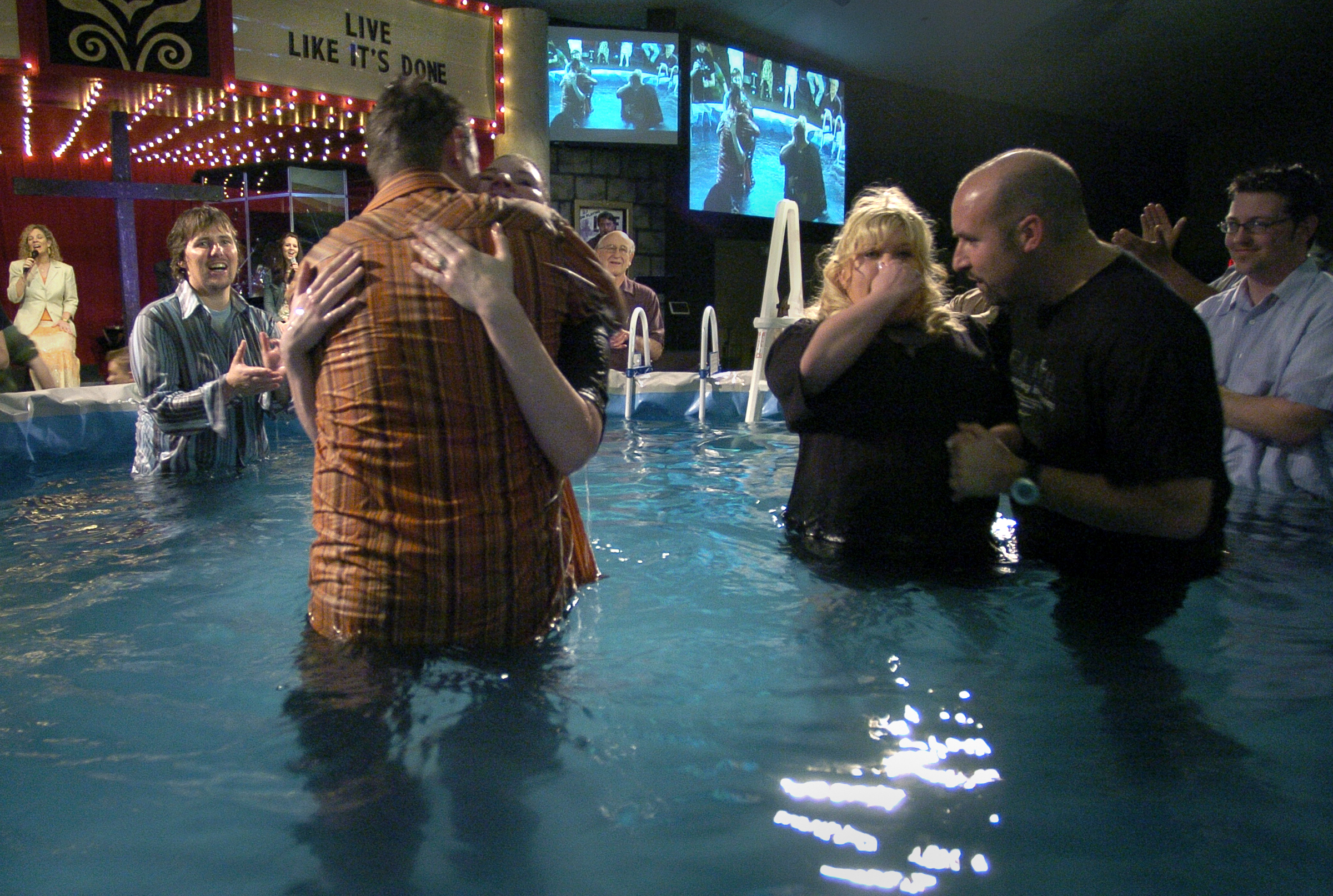Living Hope Church thrives as Bishop gains followers, starts janitorial businesses and expands the reach of his vision
Before it became an edgy, headline-grabbing house of God, Living Hope Church was just a group of friends who worshipped together.
“When we started, we didn’t have this strategic plan,” Senior Pastor John Bishop said in a 2010 YouTube video. “We didn’t have this sense of ‘We’re going to do these three things in five years.’ We just simply knew that lost people matter to God. We knew that people that are far from God need to come home to God. And we knew that believers need to grow in their faith.”
Enlarge

The Columbian files
Neal Curtiss, 62, one of Living Hope’s current lead pastors, said he knew early on that Bishop would start a church someday.
Because Bishop grew up unchurched, he understood the mentality of non-Christians and people who don’t attend church, Curtiss said. Bishop got rid of “churchy” lingo and got Living Hope to a place that really embraced unchurched people.
“Man, he hit the ground running,” Curtiss said, adding that Living Hope “really was part of (Bishop’s) heart.”
In those early days, Living Hope’s 40-some congregants gathered each week at the Manor Grange near Battle Ground. They hosted weekly potlucks and a children’s puppet ministry. The church borrowed equipment from a local music store, and once held a Christmas Eve service so intimate that everyone sat in a circle.
After it outgrew the Grange in 1999, Living Hope worshipped in Prairie High School’s auditorium for four years.
Small businesses
Faith wasn’t the only thing that grew in the church’s early years.
Bishop put his business degree to use and launched a number of small enterprises.
He ran janitorial services over the years with friends Dave Clinton, a former pastor and director of creative arts at Living Hope, and Duane Warren, a former Living Hope executive pastor. Clinton declined to be interviewed; when contacted for this story, Warren hung up the phone.
In 1996, they obtained business licenses for Team Danco Carpet Cleaning and Team Danco Janitorial. Records in Clark County District Court indicate Bishop and Clinton had started a similar business, Danco Floor Service, in the early 1990s.
In 1998, the Bishops and Clintons bought a commercial building in Vancouver’s Orchards area for their businesses.
State records show that John Bishop also obtained licenses for All American Steel Incorporated in 1998, with Clinton; Team Cleaning Concepts in 2000, with his brother-in-law Michael Shaw; Equipment Solutions in 2003, with Clinton and Shaw; Team Cleaning Company in 2006, with Genevieve Traub, the former director of finance for Living Hope; and Team Cleaning Contracting in 2006, with Traub and Clinton. Traub also declined to be interviewed.
Another business, All American Floor and Janitorial Service, was formed in 1997 by Bishop’s wife, Michelle Bishop, Clinton family members and Warren, according to records from the Secretary of State’s Office.
John Bishop said his cleaning and supply company, which underwent several name changes and restructuring over the years, served a variety of well-known stores, such as Plaid Pantry, Albertsons and Kmart.
From 1997 to 2000, at least five tax warrants for unpaid industrial insurance taxes and unpaid unemployment insurance contributions totaling nearly $26,000 were filed against Team Danco Janitorial and All American Steel Incorporated, records from the Department of Labor & Industries and the Employment Security Department show.
By 2002, the Internal Revenue Service filed a federal tax lien against Bishop for $52,336.80. It was paid the following year, according to IRS records.
“Like a lot of companies, when you’re growing rapidly, in any industry, the net effect puts a strain on finances. We were trying to make ends meet. Everything is paid now,” Bishop said.
None of the Bishops’ local businesses appear to be operating today.
Enlarge

The Columbian files
Rapid growth
As Bishop’s businesses proliferated, Living Hope thrived.
The church once again outgrew its worship space and absorbed Prairie Community Church, a struggling congregation whose pastor had recently retired.
Living Hope began holding regular services at Prairie Community Church, later referred to as the Brush Prairie campus, off state Highway 503.
Bishop obtained his Master of Arts in Specialized Ministry — with an emphasis in Evangelism and Equipping — from Western Seminary’s Portland campus in 2004, the same year Bishop has said Living Hope’s story really begins.
Enlarge

Amanda Cowan/The Columbian
He wrote in his 2011 book “Dangerous Church” that he started to realize Living Hope was stuck in the status quo.
That all changed in May 2005 when his staff lost the baptism list, leading to the church’s first spontaneous baptisms for more than 300 people over four services, Bishop wrote. Hundreds of people looking to get baptized walked into the baptismal pool in their Sunday finest.
“They were so moved by the message, they’d just walk right in there. Who does that?” said Richard Brosius, a former church member.
Brosius, now 66, said he joined Living Hope after hearing about the good the church was doing. After decades at a Baptist church, he wanted to enliven his relationship with God.
He voluntarily chaired the proposed remodel of the Brush Prairie campus, which Bishop envisioned would include an auditorium that could hold several thousand people. The church was growing so fast that it held four services on weekends.
“John Bishop was such a charismatic individual, deeply talented,” Brosius said. “He had an amazing ability to speak and be very convincing and tell stories.”
Enlarge

The Columbian files
Living Hope was the Disneyland of churches, said Jerry Romano, who was once called to help the church.
“The show was the best show in town,” he said. “John was always the icing on the cake.”
Part of the reason Bishop identified so well with the gospel is that he truly believed Jesus had saved him and that he needed deliverance, said Romano, now 66.
“His own inadequacies and need for approval plagued him. People responded to his worries over whether God would actually accept him and receive him as a son,” he said. “People could feel this guy was real. People could feel ‘This guy was as mucked up as I am.’ ”
Former congregant Doug Mabry, now 59, said he just liked the way Living Hope “did church.”
“They did it in a way to invite people who hadn’t been to church before,” he said. “John struck me as somebody who genuinely cared about individuals. He seemed very concerned not just about the church but the individuals who were there.”
Brosius said he was drawn to Living Hope, in part, because of the music, which he described as being like a concert every weekend, and then-Youth Pastor Danny Clinton.
“(Bishop) brought a really good team around him. That was part of his success,” Brosius added.
In October 2005, Living Hope merged once again, this time with Vancouver Community Church, whose pastor encouraged a young Bishop to embrace Christ.
“The pastor that led me to Christ, now I’m his pastor. It’s really cool but like really humbling,” Bishop said in a 2010 YouTube video.
Enlarge

The Columbian files
Cancer scare
It was Bishop’s success that led Living Hope to open five satellite campuses on Easter 2006, including some in local movie theaters.
“If Starbucks can do it with coffee, why not with the Bible?” Bishop said in a phone interview, referring to the church’s growth.
He referred to that time as Living Hope’s golden era.
But a sudden health crisis posed a distraction.
About two weeks before Easter, Bishop had a mole removed from his upper thigh that doctors later diagnosed as malignant melanoma.
The Bishop family asked people to pray for his health.
“I am a preacher, so I normally have words to encourage people about their situation. Now I am the one being encouraged, loved, cried over and supported. I am so overwhelmed with a sense of God’s love through all of you, that I can’t quite understand it,” Bishop wrote in an April 2006 blog post.
Bishop was to undergo surgery just days after the Easter service. “Part of me is a little freaked out about the whole surgery thing. I keep thinking how big the hole in my leg will be,” he wrote in the blog.
Tests found that the skin cancer had not spread to his blood, liver or lungs, but there were concerns about his lymphatic system. Surgeons removed two lymph nodes from the area where the mole was found.
“When they wheeled me into the waiting room, there were 30 or 40 people standing there, and I yelled, ‘Freedom!’ ” Bishop wrote after surgery.
As Bishop waited to hear whether the cancer had spread, he shared that he was having a tough time.
“I don’t feel all that brave today. I don’t feel all that excited. I feel a little today like Chicken Little, which is so not me,” Bishop wrote in a blog post.
A week after surgery, Bishop found out he was cancer-free.
“I cannot express the joy and relief I had in my heart at that moment,” Bishop said of the news in a blog post. “I also knew it wasn’t me who beat it. We beat it. All of us!”
In the Rose Garden
By Easter 2007, Bishop was back on his A-game and ready to do something big.
Six weeks before the holy day, churchgoers raised $140,000 in one offering to put together a massive Easter service. “To have that kind of offering, it was boggling my mind,” Bishop said in a recent phone interview.
Bishop attempted to rent what’s now known as the Sunlight Supply Amphitheater in Ridgefield, the Portland Expo Center and Veterans Memorial Coliseum in Portland, but nothing was available on Easter Sunday. Bishop refused to give up.
“I was talking to God in my heart,” he said.
He decided to take a chance and reached out to Portland’s Rose Garden arena (now the Moda Center), which happened to be available. It was the first time the arena, normally host to Trail Blazers games, rock concerts and shows like Disney on Ice, would host a church service.
“It was incredible, man. It was the way church is supposed to be. The news is there. The hype is there. It’s because God is there. It’s not because John is there … it’s because God showed up,” Bishop recalled.
Around the same time, Will Warren, now 62, a former pastor at Portland’s Mount Zion Baptist Church — a predominately black congregation — met Bishop when his own church was struggling financially and in dire need of repairs. Bishop was looking to expand into Portland and sold Warren on Living Hope’s vision of working with churches to build relationships and diversity.
Warren’s congregation ultimately lost its church, but Bishop still wanted Warren to join his team.
“I believed him. I didn’t see a mask. I didn’t see a liar. I didn’t see a manipulator. I didn’t see any of those things in the beginning,” Warren said. But reflecting on his experience about a decade later, he said there were red flags.
As a Living Hope staff member, Warren took part in the 2007 Easter service, heading one of four baptismal pools.
Warren recalled Bishop giving him a strange look as people began lining up at his pool. It was a look of “What gives?” he said, as if Bishop was wondering, “Who is this guy? What’s he trying to do? Is he stealing my thunder?”
The answers would come as his relationship with Bishop deepened.
Fall from grace
Part 1: The making of a man of God
Part 2: The best show in town
Part 3: ‘Can’t have two tigers on the hill’
Part 4: Blue Light Special brings new crises
Part 5: Finding new paths